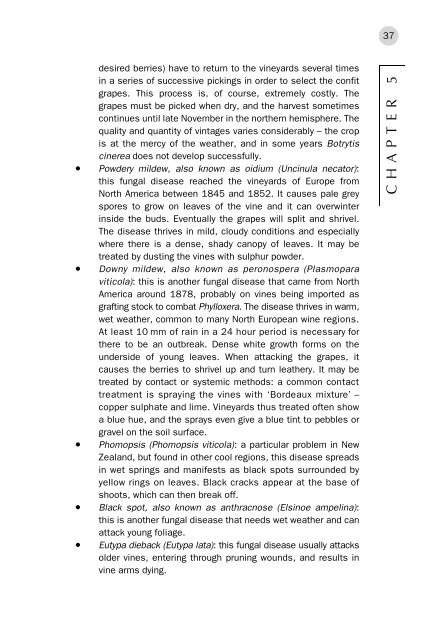Wine Production : Vine to Bottle - Vinum Vine
Wine Production : Vine to Bottle - Vinum Vine
Wine Production : Vine to Bottle - Vinum Vine
You also want an ePaper? Increase the reach of your titles
YUMPU automatically turns print PDFs into web optimized ePapers that Google loves.
37<br />
desired berries) have <strong>to</strong> return <strong>to</strong> the vineyards several times<br />
in a series of successive pickings in order <strong>to</strong> select the confit<br />
grapes. This process is, of course, extremely costly. The<br />
grapes must be picked when dry, and the harvest sometimes<br />
continues until late November in the northern hemisphere. The<br />
quality and quantity of vintages varies considerably – the crop<br />
is at the mercy of the weather, and in some years Botrytis<br />
cinerea does not develop successfully.<br />
• Powdery mildew, also known as oidium (Uncinula neca<strong>to</strong>r):<br />
this fungal disease reached the vineyards of Europe from<br />
North America between 1845 and 1852. It causes pale grey<br />
spores <strong>to</strong> grow on leaves of the vine and it can overwinter<br />
inside the buds. Eventually the grapes will split and shrivel.<br />
The disease thrives in mild, cloudy conditions and especially<br />
where there is a dense, shady canopy of leaves. It may be<br />
treated by dusting the vines with sulphur powder.<br />
• Downy mildew, also known as peronospera (Plasmopara<br />
viticola): this is another fungal disease that came from North<br />
America around 1878, probably on vines being imported as<br />
grafting s<strong>to</strong>ck <strong>to</strong> combat Phylloxera. The disease thrives in warm,<br />
wet weather, common <strong>to</strong> many North European wine regions.<br />
At least 10 mm of rain in a 24 hour period is necessary for<br />
there <strong>to</strong> be an outbreak. Dense white growth forms on the<br />
underside of young leaves. When attacking the grapes, it<br />
causes the berries <strong>to</strong> shrivel up and turn leathery. It may be<br />
treated by contact or systemic methods: a common contact<br />
treatment is spraying the vines with ‘Bordeaux mixture’ –<br />
copper sulphate and lime. <strong>Vine</strong>yards thus treated often show<br />
a blue hue, and the sprays even give a blue tint <strong>to</strong> pebbles or<br />
gravel on the soil surface.<br />
• Phomopsis (Phomopsis viticola): a particular problem in New<br />
Zealand, but found in other cool regions, this disease spreads<br />
in wet springs and manifests as black spots surrounded by<br />
yellow rings on leaves. Black cracks appear at the base of<br />
shoots, which can then break off.<br />
• Black spot, also known as anthracnose (Elsinoe ampelina):<br />
this is another fungal disease that needs wet weather and can<br />
attack young foliage.<br />
• Eutypa dieback (Eutypa lata): this fungal disease usually attacks<br />
older vines, entering through pruning wounds, and results in<br />
vine arms dying.<br />
CHAPTER 5
















